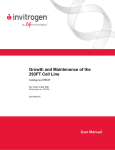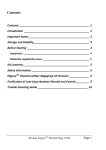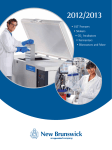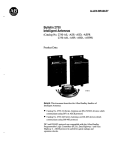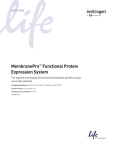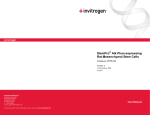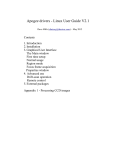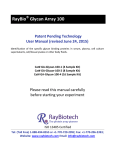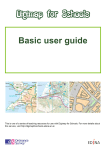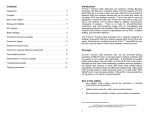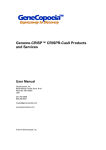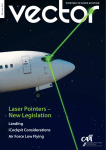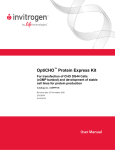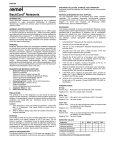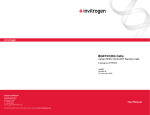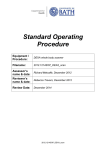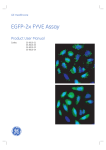Download FreeStyle 293 Expression System
Transcript
FreeStyle™ 293 Expression System For large-scale transfection of suspension 293 cells in a defined, serum-free medium Catalog no. K9000-01 Version D 28 October 2010 25-0439 Corporate Headquarters Invitrogen Corporation 1600 Faraday Avenue Carlsbad, CA 92008 T: 1 760 603 7200 F: 1 760 602 6500 E: [email protected] For country-specific contact information visit our web site at www.invitrogen.com User Manual ii Table of Contents Table of Contents ................................................................................................................................................. iii Kit Contents and Storage ..................................................................................................................................... v Introduction ................................................................................................................... 1 Overview.................................................................................................................................................................1 FreeStyle™ 293-F Cells ...........................................................................................................................................2 FreeStyle™ 293 Expression Medium ....................................................................................................................3 Methods ......................................................................................................................... 4 General Information ..............................................................................................................................................4 Thawing and Establishing Cells ..........................................................................................................................5 Subculturing Cells .................................................................................................................................................6 Freezing Cells .........................................................................................................................................................7 Transfecting Cells ..................................................................................................................................................8 Appendix...................................................................................................................... 12 pCMV SPORT-βgal..............................................................................................................................................12 Technical Service..................................................................................................................................................13 Purchaser Notification ........................................................................................................................................14 Product Qualification ..........................................................................................................................................15 References .............................................................................................................................................................16 iii iv Kit Contents and Storage Shipping/Storage The components of the FreeStyle™ 293 Expression System are shipped and should be stored as listed in the table below. For more information about the amount supplied and composition of each reagent, see below. Contents Storage Dry ice Liquid nitrogen ™ Blue ice +4°C Blue ice 2 to 8°C, in the dark Opti-MEM I Reduced-Serum Medium Blue ice 2 to 8°C, in the dark pCMV SPORT-βgal Blue ice -20°C FreeStyle 293-F Cells 293fectin ™ FreeStyle 293 Expression Medium ® FreeStyle™ 293-F Cells Shipping ™ Storage conditions: Liquid nitrogen Amount supplied: One vial containing 1 x 107 cells Composition: 1 ml of cells in 90% FreeStyle™ 293 Expression Medium and 10% DMSO. 293fectin™ Storage conditions: +4°C Amount supplied: 1 ml (sufficient for 16 transfections in a volume of 30 ml using 40 µl of 293fectin™ per transfection) Composition: 1 mg/ml transfection reagent in membrane-filtered water FreeStyle™ 293 Expression Medium Storage conditions: 2 to 8°C, in the dark Opti-MEM® I Reduced Serum Medium Storage conditions: 2 to 8°C, in the dark Amount supplied: 1 liter Composition: Proprietary, defined, serum-free medium formulated with Glutamax™-I Amount supplied: 100 ml Composition: Contains HEPES buffer, 2,400 mg/L sodium bicarbonate, hypoxanthine, thymidine, sodium pyruvate, L-glutamine, trace elements, growth factors, and phenol red reduced to 1.1 mg/L pCMV SPORT-βgal Storage conditions: -20°C Amount supplied: 25 µg Composition: 0.5 µg/µl in 10 mM Tris-HCl, pH 7.4, 5 mM NaCl, 0.1 mM EDTA v Accessory Products Introduction The products listed in this section may be used with the FreeStyle™ 293 Expression System. For more information, refer to our Web site (www.invitrogen.com) or call Technical Service (see page 13). Accessory Products The following reagents supplied in the FreeStyle™ 293 Expression System and other reagents suitable for use with the kit are available separately from Invitrogen. Ordering information is provided below. Item 1 vial (1 x 10 cells) R790-07 1L 12338-018 6x1L 12338-026 1 ml 12347-019 100 ml 31985-062 500 ml 31985-070 PureLink HiPure Plasmid Midiprep Kit PureLink™ HiPure Plasmid Maxiprep Kit PureLink™ HiPure Plasmid Filter Maxiprep Kit PureLink™ HiPure Plasmid Megaprep Kit 25 preps K2100-04 10 preps K2100-06 10 preps K2100-16 4 preps K2100-08 Trypan Blue Stain 100 ml 15250-061 pCMV SPORT-βgal 25 µg 10586-014 β-Gal Assay Kit 100 reactions K1455-01 FreeStyle 293 Expression Medium 293fectin ™ ® Opti-MEM I Reduced Serum Medium (1X), liquid ™ Protein production can also be performed in CHO cells or 293 cells using one of the FreeStyle™ MAX Expression Systems. Below the ordering information is provided for the reagents specific for the FreeStyle™ MAX Expression Systems. Item FreeStyle™ MAX 293 Expression System FreeStyle™ MAX CHO Expression System FreeStyle™ CHO-S Cells FreeStyle™ CHO Expression Medium vi 7 Catalog no. ™ FreeStyle 293-F Cells FreeStyle™ MAX Expression Systems Amount ™ Amount 25 reactions (30 ml cultures) 25 reactions (30 ml cultures) 1 vial (1 x 107 cells) 1L 6x1L Catalog no. K9000-10 K9000-20 R800-07 12651-014 12651-022 Introduction Overview Introduction The FreeStyle™ 293 Expression System is designed to allow large-scale transfection of suspension 293 human embryonic kidney cells in a defined, serum-free medium. The system includes FreeStyle™ 293-F cells that have been adapted to serum-free, suspension culture in FreeStyle™ 293 Expression Medium. Transfection and expression experiments may be performed directly in FreeStyle™ 293 Expression Medium without the need to change media. The complete FreeStyle™ 293 Expression Kit provides enough reagents to perform 16 transfections in a 30 ml volume, but larger volume transfections may be performed using simple scale-up of reagents. The FreeStyle™ 293 Expression System includes the following major components: Components of ™ the FreeStyle 293 • FreeStyle™ 293-F cells: This cell line is adapted to high density, serum-free Expression suspension culture in FreeStyle™ 293 Expression Medium and is capable of System producing high levels of recombinant protein (see the next page for more information). • FreeStyle™ 293 Expression Medium: This is a defined, serum-free medium formulated specifically to allow growth and large-scale transfection of suspension FreeStyle™ 293-F cells (see page 3 for more information). • 293fectin™: This transfection reagent provides high transfection efficiency in suspension FreeStyle™ 293-F cells. 1 FreeStyle™ 293-F Cells Introduction The FreeStyle™ 293-F cell line is supplied with the FreeStyle™ 293 Expression System and is derived from the 293 cell line (see below). FreeStyle™ 293-F cells are adapted to suspension culture in FreeStyle™ 293 Expression Medium. Frozen cells are supplied in and may be thawed directly into FreeStyle™ 293 Expression Medium (see Thawing and Establishing Cells, page 5). Parental Cell Line The 293 cell line is a permanent line established from primary embryonal human kidney transformed with sheared human adenovirus type 5 DNA (Graham et al., 1977; Harrison et al., 1977). The E1A adenovirus gene is expressed in these cells and participates in transactivation of some viral promoters, allowing these cells to produce very high levels of protein. The FreeStyle™ 293-F cell line supplied with the FreeStyle™ 293 Expression System is a variant of the 293 cell line that has been adapted to suspension growth in FreeStyle™ 293 Expression Medium. The 293-F cell line was obtained from Robert Horlick at Pharmacopeia. Characteristics of FreeStyle™ 293-F Cells The FreeStyle™ 293-F cell line exhibits the following characteristics: • Prepared from low passage Master Cell Bank cultures derived from parental 293-F cells that were re-cloned by limiting dilution. The 293 clonal derived cultures are maintained in serum-free conditions for only 30 to 35 total passages. • Adapted to high density, serum-free, suspension growth and are maintained in FreeStyle™ 293 Expression Medium. • Demonstrates high transfection efficiencies with 293fectin™. • Suspension cultures may be transfected in FreeStyle™ 293 Expression Medium without the need to change media. • Permits transfection of cells at large volumes. Other 293 cell lines may be used with the FreeStyle™ 293 Expression System. Before these cell lines may be used for transfection studies, however, they must be adapted to serum-free, suspension culture in FreeStyle™ 293 Expression Medium and evaluated for transfection and expression. 2 FreeStyle™ 293 Expression Medium Introduction FreeStyle™ 293 Expression Medium is a defined, serum-free medium specifically developed for the high-density, suspension culture and transfection of 293 cells. The medium contains NO human or animal origin components. Features of the Medium FreeStyle™ 293 Expression Medium exhibits the following features: Glutamax™-I • An optimized, serum-free, protein-free formulation designed to support the high-density culture and transfection of 293 cells (e.g. FreeStyle™ 293 cells) in suspension. The medium is not recommended for adherent 293 cell culture. • Prepared ready-to-use, with no supplementation required. • Contains no human or animal-origin products. • Formulated with Glutamax™-I (see below) to increase stability and maximize shelf life. • Supports the large-scale, high-density growth of FreeStyle™ 293-F cells in bioreactors. Glutamax™-I media contain the dipeptide, L-alanyl-L-glutamine, a stabilized form of L-glutamine. With Glutamax™-I media: • L-glutamine does not degrade in storage or during incubation • Ammonia build-up is minimized • Glutamine delivery is controlled • L-glutamine does not need to be added at the time of use. Note: Glutamax™-I is only removed from the medium by cell metabolism. There is no accumulation of toxic metabolites due to spontaneous breakdown. Growth Characteristics of FreeStyle™ 293-F Cells in the Medium Typically, FreeStyle™ 293-F cells cultured in FreeStyle™ 293 Expression Medium demonstrate the following: • Doubling time in the range of 20-25 hours Note: The doubling time can exceed 25 hours during the first few passages after the cells have been thawed. • Cell densities of up to 3 x 106 cells/ml in shaker or spinner culture • Cell densities of up to 4 x 106 cells/ml in bioreactor culture Note: Individual culturing and passaging techniques coupled with cellular heterogeneity inherent within the FreeStyle™ 293-F cell population may result in experimental variability. 3 Methods General Information General Cell Handling Follow the general guidelines below to grow and maintain FreeStyle™ 293-F cells. • All solutions and equipment that come in contact with the cells must be sterile. Always use proper sterile technique and work in a laminar flow hood. • Before starting experiments, be sure to have cells established and also have some frozen stocks on hand. We recommend using early-passage cells for your experiments. Upon receipt of the cells from Invitrogen, grow and freeze multiple vials of the FreeStyle™ 293-F cell line to ensure that you have an adequate supply of early-passage cells. • For general maintenance of cells, pass FreeStyle™ 293-F cells when they reach a density of approximately 1-3 x 106 viable cells/ml (generally every 3-4 days). • Use trypan blue exclusion to determine cell viability (see below). Log phase cultures should be >90% viable. • When thawing or subculturing cells, transfer cells into pre-warmed medium. As with other human cell lines, when working with FreeStyle™ 293-F cells, handle as potentially biohazardous material under at least Biosafety Level 2 containment. Preparing Media Important Determining Cell Density and Viability 4 For suspension growth and transfection applications, use: • FreeStyle™ 293 Expression Medium as is. No supplementation is required. • Antibiotics are not recommended; however, 5 ml/L of AntibioticAntimycotic (Catalog no. 15240) containing penicillin, streptomycin, and amphotericin B may be used when required. FreeStyle™ 293 Expression Medium is extremely sensitive to light. For optimal results, use and store media protected from light. Follow the procedure below to determine viable and total cell counts. 1. Transfer a small aliquot of the cell suspension to a microcentrifuge tube. 2. Determine viability and the amount of cell clumping using the trypan blue dye exclusion method. 3. Vigorously vortex for 10-30 seconds to break up cell clumps. 4. Determine cell density electronically using a Coulter Counter or manually using a hemacytometer. Thawing and Establishing Cells Introduction Follow the protocol below to thaw FreeStyle™ 293-F cells to initiate cell culture. The FreeStyle™ 293-F cell line is supplied in a vial containing 1 ml of cells at 1 x 107 viable cells/ml in 90% FreeStyle™ 293 Expression Medium and 10% DMSO. Thaw FreeStyle™ 293-F cells directly into the FreeStyle™ 293 Expression Medium supplied with the kit. Materials Needed You will need to have the following reagents on hand before beginning: • FreeStyle™ 293-F cells (supplied with the kit; store frozen cells in liquid nitrogen until ready to use) • FreeStyle™ 293 Expression Medium (supplied with the kit; pre-warmed) Note: We do not recommend adding antibiotics to media as this may negatively impact cell growth. Thawing Procedure • 125 ml polycarbonate, disposable, sterile Erlenmeyer flask • Orbital shaker in 37°C incubator with a humidified atmosphere of 8% CO2 • Room temperature table-top centrifuge and sterile centrifuge tubes • Reagents to determine viable and total cell counts • Sterile, 50 ml conical tubes Store frozen cells in liquid nitrogen until ready to use. To thaw and establish cells: 1. Remove the cryovial of cells from the liquid nitrogen and thaw quickly in a 37°C water bath. 2. Just before the cells are completely thawed, decontaminate the outside of the vial with 70% ethanol. Triturate and transfer the entire contents of the cryovial into a 125 ml polycarbonate, disposable, sterile Erlenmeyer shaker flask containing 17 ml of pre-warmed FreeStyle™ 293 Expression Medium. 3. Incubate cells in a 37°C incubator containing a humidified atmosphere of 8% CO2 in air on an orbital shaker platform rotating at 125 rpm. Loosen the cap of the flask a quarter turn from snug to allow oxygenation/aeration. 4. Once the culture has reached greater than 1 x 106 viable cells/ml (typically 3 to 5 days), transfer the cell suspension aseptically into a centrifuge tube and vortex for 10 seconds. 5. Determine viable and total cell counts (see protocol on page 4). 6. Subculture the FreeStyle™ 293-F cells by seeding shaker flasks at 3 x 105 viable cells/ml in pre-warmed FreeStyle™ 293 Expression Medium. We generally use 125 or 250 ml polycarbonate, disposable, sterile, Erlenmeyer flasks containing 20 or 40 ml total working volume of cell suspension, respectively. Important Note: Subculture cells a minimum of two additional times before use in transfection experiments to allow opportunity for recovery from thawing. To subculture cells, see the procedure on the next page. 5 Subculturing Cells Subculture cells when the density is approximately 2-3 x 106 viable cells/ml, typically every 3-4 days. When maintaining FreeStyle™ 293-F cells, we generally use a 125 or 250 ml polycarbonate, disposable, sterile Erlenmeyer flask containing 25 to 40 ml or 50 to 80 ml total working volume of cell suspension, respectively. Note: Glass flasks without baffles may be used, but thorough cleaning after each use is essential to avoid potential toxicity which is more problematic in serum-free cultures. 1. Determine viable and total cell counts (see protocol on page 4). 2. Using the cell density determined in Step 1, calculate the split ratio needed to seed the new shaker flask at 3 x 105 viable cells/ml. 3. Dilute the cells in fresh, pre-warmed FreeStyle™ 293 Expression Medium to give a final cell density of 0.1-0.2 x 106 viable cells/ml in the desired final volume. 4. Incubate flasks in a 37°C incubator containing a humidified atmosphere of 8% CO2 in air on an orbital shaker platform rotating at 135 rpm. 5. Repeat Steps 1-5 as necessary to maintain or expand cells. Monitor the degree of cell clumping (see below). MEND ION AT RECOM Passaging Cells Scaling Up Cell Culture FreeStyle™ 293-F suspension cultures may grow as 2 to 10 cell clusters. Vigorous vortexing for 10-30 seconds may be required at each subculture for a number of passages until the cultures grow predominantly as single cells. It is possible to scale up the FreeStyle™ 293-F cultures in spinner flasks or bioreactors. The appropriate spinner or impeller speed and seeding density should be determined and optimized for each system. At Invitrogen, the optimum spinner speed was 100-130 rpm and 70-100 rpm impeller speed in Celligen™ stirred tank bioreactors. We recommend seeding cells at 3-5 x 105 viable cells/ml. MEND ION AT RECOM Note: If the split ratio of cells to fresh media is less than 1:2, you may want to spin down the cell suspension and resuspend the cell pellet in fresh, pre-warmed FreeStyle™ 293 Expression Medium prior to inoculating the spinner or bioreactor culture. Monitor cell viability and the degree of cell clumping. Note that extensive cell clumping may reduce transfection efficiency. At high stirring speeds (i.e. greater than 130 rpm) and/or depending on the impeller design, you may want to supplement the FreeStyle™ 293 Expression Medium with additional Pluronic® F-68 (2.5-5 ml/L of 10% Pluronic® F-68, Catalog no. 24040) to avoid sheer stress in the culture. Pluronic® is a registered trademark of BASF Corporation. Celligen™ is a registered trademark of New Brunswick Corp. 6 Freezing Cells Introduction You may freeze FreeStyle™ 293-F cells directly in FreeStyle™ 293 Expression Medium. When freezing the FreeStyle™ 293-F cell line, we recommend the following: • Freeze cells at a density of 5-8 x 106 viable cells/ml. • Use a freezing medium composed of 90% fresh FreeStyle™ 293 Expression Medium and 10% DMSO. Guidelines to prepare freezing medium and to freeze cells are provided in this section. Preparing Freezing Medium Prepare freezing medium immediately before use. 1. 2. Freezing Cells In a sterile, conical centrifuge tube, mix together the following reagents for every 1 ml of freezing medium needed: FreeStyle™ 293 Expression Medium 0.9 ml DMSO 0.1 ml Filter-sterilize the freezing medium and place the tube on ice until use. Discard any remaining freezing medium after use. Before starting, label cryovials and prepare freezing medium. Keep the freezing medium on ice. 1. Grow the desired quantity of FreeStyle™ 293-F cells in shaker flasks, harvesting when the cell density reaches 0.5 to 1 x 106 viable cells/ml. Transfer cells to a sterile, conical centrifuge tube. 2. Determine the viable and total cell counts (see protocol on page 4) and calculate the volume of freezing medium required to yield a final cell density of 5-8 x 106 viable cells/ml. 3. Centrifuge cells at 100 x g for 5 minutes at room temperature and carefully aspirate the medium. 4. Resuspend the cells in the pre-determined volume of chilled freezing medium. 5. Place cryovials in a microcentrifuge rack and aliquot 1 ml of the cell suspension into each cryovial. 6. Freeze cells in an automated or manual, controlled-rate freezing apparatus following standard procedures. For ideal cryopreservation, the freezing rate should be a decrease of 1°C per minute. 7. Transfer frozen vials to liquid nitrogen for long-term storage. Note: You may check the viability and recovery of frozen cells 24 hours after storing cryovials in liquid nitrogen by following the procedure outlined in Thawing and Establishing Cells, page 5. 7 Transfecting Cells Introduction To transfect suspension FreeStyle™ 293-F cells, you will use the cationic lipid-based transfection reagent, 293fectin™ included with the kit. Unlike some other serumfree media formulations, FreeStyle™ 293 Expression Medium does not inhibit cationic lipid-mediated transfection. FreeStyle™ 293 Expression Medium is specifically formulated to allow high efficiency transfection of suspension FreeStyle™ 293-F cells without the need to change or add media. Transient transfection experiments may be performed in a large volume, allowing largerscale protein production. 293fectin™ 293fectin™ is a proprietary formulation suitable for transfection of nucleic acids into eukaryotic cells. In the FreeStyle™ 293 Expression System, use of 293fectin™ to transfect FreeStyle™ 293-F cells provides the following advantages: • 293fectin™ demonstrates high transfection efficiency in suspension FreeStyle™ 293-F cells (cultured in FreeStyle™ 293 Expression Medium) • DNA-293fectin™ complexes can be added directly to cells in culture medium • It is not necessary to remove complexes or change or add medium following transfection 293fectin™ is available separately from Invitrogen (see page Error! Bookmark not defined. for ordering information). For more information, see our Web site (www.invitrogen.com) or call Technical Service (see page 13). Opti-MEM® I Opti-MEM® I Reduced Serum Medium is included with the FreeStyle™ 293 Expression System to facilitate optimal formation of DNA-293fectin™ complexes. Opti-MEM® I is a modification of Eagle’s Minimal Essential Medium, buffered with HEPES and sodium bicarbonate, and supplemented with hypoxanthine, thymidine, sodium pyruvate, L-glutamine, trace elements, and growth factors. The protein level is minimal (15 µg/ml) with insulin and transferrin being the only protein supplements. Phenol red is included at a reduced concentration as a pH indicator. Opti-MEM® I Reduced Serum Medium is available separately from Invitrogen (see page Error! Bookmark not defined. for ordering information). For more information, see our Web site (www.invitrogen.com) or call Technical Service (see page 13). Positive Control pCMV SPORT-βgal is provided as a positive control vector for transfection and expression in FreeStyle™ 293-F cells. The gene encoding β-galactosidase is expressed in FreeStyle™ 293-F cells under the control of the human cytomegalovirus (CMV) promoter. Successful transfection will result in β-galactosidase expression that is easily assayed (see the next page). For a map of pCMV SPORTβgal, see page 12. Assay for β-galactosidase Activity You may evaluate β-galactosidase expression by activity assay using cell-free lysates (Miller, 1972). Invitrogen offers the β-Gal Assay Kit (Catalog no. K1455-01) for fast and easy detection of β-galactosidase expression. continued on next page 8 Transfecting Cells, continued Plasmid Preparation Plasmid DNA for transfection into eukaryotic cells must be clean, sterile and free from phenol and sodium chloride. Contaminants may kill the cells, and salt will interfere with complexing, decreasing transfection efficiency. We recommend isolating plasmid DNA using one of the Purelink™ HiPure Plasmid Kits (Catalog no. K2100-14 or K2100-16). Note: Make sure your DNA preparation is sterile, for instance by performing filtration through a 0.22 µm filter before use. Materials to Have on Hand You will need to have the following reagents on hand before beginning: • Suspension FreeStyle™ 293-F cells cultured in FreeStyle™ 293 Expression Medium Recommendation: Calculate the number of cells that you will need for your transfection experiment and expand cells accordingly. Make sure that the cells are healthy and greater than 90% viable before proceeding to transfection. • Purified plasmid DNA of interest • 293fectin™ (supplied with the kit; store at +4°C until use) • Opti-MEM® I Reduced Serum Medium (supplied with the kit; pre-warmed) • FreeStyle™ 293 Expression Medium (supplied with the kit; pre-warmed) Note: Do not add antibiotics to media during transfection as this may decrease transfection activity. • 125 ml polycarbonate, disposable, sterile Erlenmeyer flasks • Orbital shaker in 37°C incubator with a humidified atmosphere of 8% CO2 • Room temperature table-top centrifuge and sterile, conical centrifuge tubes • Reagents to determine viable and total cell counts • Sterile, disposable, polycarbonate snap-cap tubes • Vortex mixer We generally perform transfection experiments in a 30 ml volume. To transfect Optimal suspension FreeStyle™ 293-F cells, we recommend using the following optimized Conditions for 30 ml Transfection conditions: • Final transfection volume: 30 ml • Number of cells to transfect: 3 x 107 cells (final cell density of 1 x 106 cells/ml) • Amount of plasmid DNA: 20-40 µg (we typically use 30 µg) • Amount of 293fectin™: 40-80 µl (we typically use 60 µl). Use 2 µl 293fectin™ per 1 µg of plasmid DNA transfected If you are using other 293 cells, you may want to test varying amounts of 293fectin™ (e.g. 30, 40, 50, 60, 80 µl) with 30 µg plasmid DNA to determine the optimal conditions for transfection. continued on next page 9 Transfecting Cells, continued Transfection Procedure Follow the procedure below to transfect suspension FreeStyle™ 293-F cells in a 30 ml volume. Remember that you may keep the cells in FreeStyle™ 293 Expression Medium during transfection. We recommend including a positive control (pCMV SPORT-βgal) and a negative control (no DNA, no 293fectin™) in your experiment. 1. The day before transfection (day 1), determine the number of cells that you will need for your experiment. Remember that for each 30 ml transfection, you will need 3 x 107 cells in 28 ml of FreeStyle™ 293 Expression Medium. Tip: To transfect cells on day 2, seed cells at a density of 6~7 x 105 viable cells/ml. To transfect on day 3, seed cells at a density of 3~4 x 105 cells/ml. 2. On the day of transfection, transfer a small aliquot of the cell suspension to a microcentrifuge tube and determine viability and the amount of cell clumping using the trypan blue dye exclusion method. Vigorously vortex for 45 seconds to break up cell clumps and determine total cell counts using a Coulter Counter or a hemacytometer. Viability of cells must be over 90%. Important: For optimal transfection results, make sure that you have a single cell suspension. It may be necessary to vortex the cells for 10 to 30 seconds. 3. Calculate the volume of cell suspension containing the number of cells needed for one transfection (for each 30 ml transfection, you will need 3 x 107 cells). Place the shaker flask containing cells in a 37°C incubator on an orbital shaker. 4. For each transfection sample, prepare lipid-DNA complexes by performing the following: • Dilute 30 µg of plasmid DNA in Opti-MEM® I to a total volume of 1 ml. Mix gently. • Dilute 60 µl of 293fectin™ in Opti-MEM® I to a total volume of 1 ml. Mix gently and incubate for 5 minutes at room temperature. Note: Longer incubation times may result in decreased activity. • After the 5 minute incubation, add the diluted DNA to the diluted 293fectin™ to obtain a total volume of 2 ml. Mix gently. • Incubate for 20-30 minutes at room temperature to allow the DNA293fectin™ complexes to form. 5. While the DNA-293fectin™ complexes are incubating, remove the cell suspension from the incubator and add the appropriate volume of cell suspension (see step 3) into each sterile, disposable 125 ml Erlenmeyer shaker flask. Add fresh, pre-warmed FreeStyle™ 293 Expression Medium up to a total volume of 28 ml for a 30 ml transfection. 6. After the DNA-293fectin™ complex incubation is complete, add the 2 ml of DNA-293fectin™ complex to each shaker flask from Step 4. To the negative control flask, add 2 ml of Opti-MEM® I instead of DNA-293fectin™ complex. Each flask should contain a total volume of 30 ml, with a final cell density of approximately 1 x 106 viable cells/ml 7. Incubate the cells in a 37°C incubator with a humidified atmosphere of 8% CO2 in air on an orbital shaker rotating at 125 rpm. 8. Harvest cells or media (if recombinant protein is secreted) at approximately 48 hours post-transfection and assay for recombinant protein expression. continued on next page 10 Transfecting Cells, continued Optimizing Protein Expression levels may vary depending on the nature of your recombinant protein; therefore, you may want to perform a time course (i.e. harvest cells or media at 24, Expression 48, 72, 96 hours post-transfection) to optimize expression of your recombinant protein. It is possible to perform transfection experiments in a larger (e.g. 1 liter) volume. If you wish to transfect suspension FreeStyle™ 293-F cells in a larger volume, scale up the volume of each reagent accordingly. The table below lists suggested conditions to use when transfecting FreeStyle™ 293-F cells in a 1 liter or 3.8 liter volume. The optimized conditions to use when transfecting FreeStyle™ 293-F cells in a 30 ml volume are listed as a reference. Note that transfection conditions may vary depending on the type of culture vessel used and the growth conditions of your cells; therefore, you may want to perform pilot studies to optimize your transfection conditions. Scaling Up Transfections Transfection Volume Total Number of Cells* 30 ml 3 x 107 1 liter 9 3.8 liter 1 x 10 3.8 x 10 9 Amount of DNA DNA Dilution Amount of Volume (in 293fectin™ ® Opti-MEM I) 293fectin™ Dilution Volume (in Opti-MEM® I) Lipid/DNA Complex Volume 30 µg to 1 ml 60 µl to 1 ml 2 ml 1 mg to 35 ml 2 ml to 35 ml 70 ml 3.8 mg to 125 ml 7.6 ml to 125 ml 250 ml *Final cell density of 1 x 106 cells/ml The transfection efficiency may decrease as the volume increases if the FreeStyle™ 293-F cells are not growing as a single-cell suspension (i.e. if significant cell clumping is observed). 11 Appendix pCMV SPORT-βgal Description pCMV SPORT-βgal is included in the FreeStyle™ 293 Expression System for use as a transfection and expression control, and contains the lacZ gene cloned into pCMV SPORT1. The plasmid uses the human cytomegalovirus (CMV) promoter to control expression of β-galactosidase. The complete sequence of pCMV SPORT-βgal is available for downloading from our Web site (www.invitrogen.com) or by calling Technical Service (see page 13). T7 Z lac incA f1 0 pA SV4 A m p i c i l li n pCMV SPORT-bgal 7854 bp lo xP Comments for pCMV SPORT-bgal: 7854 nucleotides SP 6 pU C o ri P C MV SV40 small T intron and polyA signal: bases 193-555 (complementary strand) T7 promoter: bases 645-664 lacZ ORF: bases 1009-4149 (complementary strand) SP6 promoter: bases 4259-4278 (complementary strand) CMV promoter: bases 4308-4901 (complementary strand) pUC origin: bases 5390-6063 (complementary strand) loxP: bases 6115-6148 Ampicillin (bla) resistance gene: bases 6250-7110 (complementary strand) incA: bases 7134-7306 f1 intergenic region: bases 7579-7854 (complementary strand) 12 Technical Service Web Resources Visit the Invitrogen website at www.invitrogen.com for: • Technical resources, including manuals, vector maps and sequences, application notes, MSDSs, FAQs, formulations, citations, handbooks, etc. • Complete technical support contact information • Access to the Invitrogen Online Catalog • Additional product information and special offers For more information or technical assistance, call, write, fax, or email. Additional international offices are listed on our website (www.invitrogen.com). Corporate Headquarters: Japanese Headquarters: European Headquarters: Invitrogen Corporation Invitrogen Japan Invitrogen Ltd 1600 Faraday Avenue LOOP-X Bldg. 6F Inchinnan Business Park Carlsbad, CA 92008 USA 3-9-15, Kaigan 3 Fountain Drive Tel: 1 760 603 7200 Minato-ku, Tokyo 108-0022 Paisley PA4 9RF, UK Tel (Toll Free): 1 800 955 6288 Tel: 81 3 5730 6509 Tel: +44 (0) 141 814 6100 Fax: 1 760 602 6500 Fax: 81 3 5730 6519 Tech Fax: +44 (0) 141 814 6117 E-mail: [email protected] E-mail: [email protected] E-mail: [email protected] Contact Us MSDS MSDSs (Material Safety Data Sheets) are available on our website at www.invitrogen.com/msds. Limited Warranty Invitrogen is committed to providing our customers with high-quality goods and services. Our goal is to ensure that every customer is 100% satisfied with our products and our service. If you should have any questions or concerns about an Invitrogen product or service, contact our Technical Service Representatives. Invitrogen warrants that all of its products will perform according to specifications stated on the certificate of analysis. The company will replace, free of charge, any product that does not meet those specifications. This warranty limits Invitrogen Corporation’s liability only to the cost of the product. No warranty is granted for products beyond their listed expiration date. No warranty is applicable unless all product components are stored in accordance with instructions. Invitrogen reserves the right to select the method(s) used to analyze a product unless Invitrogen agrees to a specified method in writing prior to acceptance of the order. Invitrogen makes every effort to ensure the accuracy of its publications, but realizes that the occasional typographical or other error is inevitable. Therefore Invitrogen makes no warranty of any kind regarding the contents of any publications or documentation. If you discover an error in any of our publications, please report it to our Technical Service Representatives. Invitrogen assumes no responsibility or liability for any special, incidental, indirect or consequential loss or damage whatsoever. The above limited warranty is sole and exclusive. No other warranty is made, whether expressed or implied, including any warranty of merchantability or fitness for a particular purpose. 13 Purchaser Notification Introduction Use of the FreeStyle™ 293 Expression System is covered under a number of different licenses including those detailed below. Information for European Customers The FreeStyle™ 293-F Cell Line is genetically modified and carries human adenovirus type 5 DNA. As a condition of sale, this product must be in accordance with all applicable local legislation and guidelines including EC Directive 90/219/EEC on the contained use of genetically modified organisms. Limited Use Label License No. 5 Invitrogen Technology The purchase of this product conveys to the buyer the non-transferable right to use the purchased amount of the product and components of the product in research conducted by the buyer (whether the buyer is an academic or for-profit entity). The buyer cannot sell or otherwise transfer (a) this product (b) its components or (c) materials made using this product or its components to a third party or otherwise use this product or its components or materials made using this product or its components for Commercial Purposes. The buyer may transfer information or materials made through the use of this product to a scientific collaborator, provided that such transfer is not for any Commercial Purpose, and that such collaborator agrees in writing (a) not to transfer such materials to any third party, and (b) to use such transferred materials and/or information solely for research and not for Commercial Purposes. Commercial Purposes means any activity by a party for consideration and may include, but is not limited to: (1) use of the product or its components in manufacturing; (2) use of the product or its components to provide a service, information, or data; (3) use of the product or its components for therapeutic, diagnostic or prophylactic purposes; or (4) resale of the product or its components, whether or not such product or its components are resold for use in research. For products that are subject to multiple limited use label licenses, the terms of the most restrictive limited use label license shall control. Life Technologies Corporation will not assert a claim against the buyer of infringement of patents owned or controlled by Life Technologies Corporation which cover this product based upon the manufacture, use or sale of a therapeutic, clinical diagnostic, vaccine or prophylactic product developed in research by the buyer in which this product or its components was employed, provided that neither this product nor any of its components was used in the manufacture of such product. If the purchaser is not willing to accept the limitations of this limited use statement, Life Technologies is willing to accept return of the product with a full refund. For information about purchasing a license to use this product or the technology embedded in it for any use other than for research use please contact Out Licensing, Life Technologies, 5791 Van Allen Way, Carlsbad, California 92008; Phone (760) 603-7200 or e-mail: [email protected]. 14 Product Qualification Introduction This section describes the criteria used to qualify the components of the FreeStyle™ 293 Expression System. FreeStyle™ 293-F Cells Each lot of cells is tested for cell growth and viability post-recovery from cryopreservation. Master Cell Banks are screened for viruses, mycoplasma, and sterility. Species identity is confirmed by isozyme and karyotype analysis. FreeStyle™ 293 Expression Medium Each lot of FreeStyle™ 293 Expression Medium is tested to ensure conformance with the most current approved product specification. This currently consists of tests for pH, osmolality, endotoxin, sterility, and a three-passage 293 Performance Assay. For individual lot test results and more information, contact Gibco® Technical Service at 1-800-828-6686. 293fectin™ • 293fectin™ is tested functionally in a transfection using a luciferase reportercontaining plasmid. • 293fectin™ is tested for the absence of microbial contamination using blood agar plates, Sabaraud dextrose agar plates, and fluid thioglycolate medium. • Opti-MEM® I is subjected to pH, osmolality, endotoxin, bacterial, fungal, and mycoplasma testing. The endotoxin level is less than 1.0 EU/mL. • Each lot of Opti-MEM® I is evaluated utilizing sensitive quantitative assays for its ability to support cloning efficiency of a murine myeloma cell line, and growth over multiple subcultures of an adherent cell line. Test lots of OptiMEM® I at 2% (CHO growth) and 4% (Sp2 cloning) serum supplementation are compared to a previously approved Opti-MEM® I control. • Gibco® cell culture liquid products are prepared by an aseptic process for which each step has been validated to ensure that all products meet the industry standard sterility assurance level of 10-3, i.e., product that demonstrates a contamination level of no more than 1 of 1000 units during the manufacturing process. The highest level of sterility assurance (equal to or greater than 10-6) cannot be achieved without terminal sterilization which is harmful to the performance of cell culture products. Opti-MEM® I Reduced Serum Medium pCMV SPORT-βgal The pCMV SPORT-βgal plasmid has passed the following quality control assays: • Purity, DNA structure, and selected restriction sites are verified by agarose gel analysis • Expression of β-gal activity is verified by transfection into BHK-21 cells and in situ staining with X-gal. 15 References Graham, F. L., Smiley, J., Russell, W. C., and Nairn, R. (1977). Characteristics of a Human Cell Line Transformed by DNA from Human Adenovirus Type 5. J. Gen. Virol. 36, 59-74. Harrison, T., Graham, F., and Williams, J. (1977). Host-range Mutants of Adenovirus Type 5 Defective for Growth in HeLa Cells. Virology 77, 319-329. Miller, J. H. (1972). Experiments in Molecular Genetics (Cold Spring Harbor, New York: Cold Spring Harbor Laboratory). ©2002-2007, 2010 Invitrogen Corporation. All rights reserved. For research use only. Not intended for any animal or human therapeutic or diagnostic use. 16 Corporate Headquarters Invitrogen Corporation 1600 Faraday Avenue Carlsbad, CA 92008 T: 1 760 603 7200 F: 1 760 602 6500 E: [email protected] For country-specific contact information visit our web site at www.invitrogen.com User Manual























